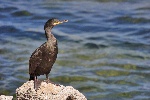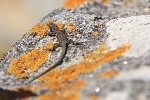Cies Islands
Fauna
The important amount of sea birds that inhabit Cíes islands led to it being declared a special bird protection zone (ZEPA) by the Spanish government and the European Community.
The most numerous species in the reserve is Yellow-legged gull (Larus cachinnans). There are 22,000 breeding pairs which makes this the largest colony in the world. This bird is quite similar to the Herring gull (Larus argentatus), but is basically differentiated by the colour of its legs (hence its name).
There are 1,000 breeding pairs of shag (Phalacrocorax aristotelis) which is the largest colony in southwest Europe.
Other bird species found to a lesser extent are some pairs of Lesser Black-backed gull (Larus fuscus) and storm petrels (Hydrobates pelagicos), both species common to the Iberian Peninsula. There are also other types of birds such as the gannet (Morus bassanus), goshawk (Accipiter gentilis), black-throated diver (Gavia arctica), peregrine falcon (Falco peregrinus), Manx shearwater (Puffinus puffinus), Black-headed gull (Larus radibundus), and common murre (Uria aalge) which are present on the island but do not breed. Many bird species nest, hibernate or rest on the islands as they migrate.
Wild mammals found on the island are rabbits (Oryctolagus cuniculus), hedgehogs (Atelerix algirus) and occasionally, some otters (Lutra lutra). Some reptiles can also be seen such as Bedriagai’s skink (Chalcides bedriagai), the jewelled lacerta (Lacerta Lepida), lizards (Lacerta hispanica) and small snakes, all of which are harmless and non-poisonous. Amphibian animals are infrequent.
Concello de Vigo
Praza do Rei - 36202 - Vigo (Pontevedra) - Teléfono: 010 - 986810100




